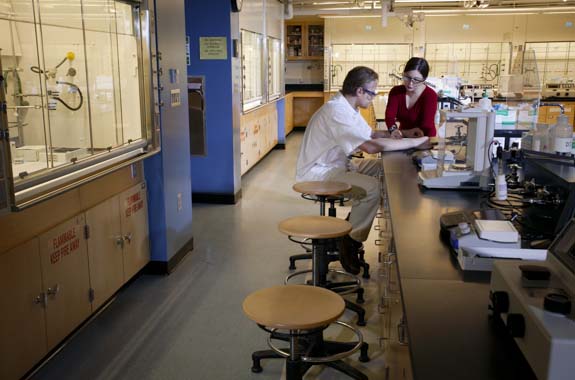Facilities & Labs
A key strength of the Chemical Engineering Department at WPI is our research, conducted in our state-of-the-art facilities and labs. Undergraduate and graduate students work with faculty and within interdisciplinary teams, using cutting-edge equipment and processes to make discoveries that can benefit the world at large.
Our two main facilities are Goddard Hall, home to the Chemistry and Biochemistry and Chemical Engineering departments; and the Life Sciences and Bioengineering Center at Gateway Park, where the departments of Chemical Engineering, Biology and Biotechnology, Chemistry and Biochemistry, and Biomedical Engineering work together to conduct interdisciplinary research.

Research Centers
- Center for Inorganic Membrane Studies (CIMS): The center aims to develop industry and university collaboration for inorganic membrane research, and to promote and expand the science of inorganic membranes as a technological base for industrial applications through fundamental research. Under the direction of Professor Yi Hua Ma, the center takes an interdisciplinary approach to assemble essential skills in synthesis, modeling, material characterization, diffusion measurements, and general properties determinations of inorganic membranes. Learn more about CIMS…
- Fuel Cell Center (FCC): This university-industry alliance is involved with research and development of fuel cells, fuel reformers, hydrogen production, and related technology for mobile and stationary applications.
Research Groups & Laboratories
- Adsorption and Diffusion Laboratory: This lab studies the adsorption and diffusion of gases and vapors in porous materials such as zeolites, molecular sieve carbons, porous alumina, and hollow-fiber inorganic membranes.
- Bacterial Adhesion and Interaction Forces Laboratory: This lab, headed by Professor Terri Camesano, studies imaging bacteria, biopolymers, and colloidal particles; probes bacterial interaction forces with atomic force microscopy; and conducts biopolymer conformation studies.
- Bioengineering Institute Center for Biomaterials: Researchers here develop biocompatible materials that can be used to fabricate innovative, highly functional implantable devices. These include sensors, therapeutics, prosthetics, and surgical aids, such as catheters and stents. Technologies developed in the center have been targeted for commercialization.
- Bioengineering Institute Center for Water Research: The focus here is on novel ways of remediating water, taking advantage of hydrophobic molecular sieves and liquid-phase oxidation chemistry. Compounds being investigated include pharmaceuticals and personal-care products; hormones and metabolites; antioxidants; steroids and growth stimulants; pesticides and insecticides; and fragrances, solvents, fire retardants, and plasticizer.
- Biological Interaction Forces Laboratory: Experimental work in this lab aims to characterize microbiological and biological systems (bacterial cells, biopolymers, other types of cells, etc.) at the nanoscale. The main piece of equipment used is an atomic force microscope, which can operate in liquids or under ambient conditions. Computers with sophisticated image analysis software are used to quantify phenomena observed in the images. A laminar flow hood is used for working with sterile cultures, with ample wet chemistry space to prepare. Learn more about Biological Interaction Forces Laboratory…
- Catalyst and Reaction Engineering Laboratory: Research in this lab focuses on novel catalyst development, fuels and chemicals from renewable resources, catalytic reactor-separators, catalytic micro-kinetics, and diffusional transport in porous catalysts and in membranes.
- Fuel Cell Laboratory: The objective is to develop integrated catalytic reformer-fuel cell systems for future automobiles. Fuel cells emit virtually no emissions, apart from those produced by the reformer, and can provide twice the energy efficiency of conventional IC engines. Learn more about the Fuel Cell Laboratory…
- Heat and Mass Transfer Laboratory: This laboratory is mainly computational. Workstations are dedicated to the application of computational fluid dynamics to transport problems in chemical reaction engineering. Current research interests include simulation of flow and heat transfer in packed-bed reactors and membrane reactors. Capabilities also exist in this lab for simulation of gas dynamics in microchannels. Experimental facilities include the measurement of heat and mass transfer coefficients in packed columns. Learn more about Heat and Mass Transfer Laboratory…
- Zeolite Crystallization Laboratory: This laboratory is equipped for hydrothermal syntheses of molecular sieve zeolites over a wide range of temperature, chemical composition, and hydrodynamic conditions. The objective is to understand how zeolites nucleate and grow. Synthesis results are characterized by optical and electron microscopy, X-ray diffraction, and particle size analysis.
Teaching Facilities
In our teaching facilities, theory meets practice. Our world-class faculty guides students as they learn chemical engineering’s basics and then apply them to gain hands-on knowledge.
Our tri-level, state-of-the-art unit operations laboratory in the center of Goddard Hall allows undergraduate students to apply chemical engineering’s fundamental theories in a lab setting, running real chemical operations. This lab supports work in bioreactor engineering, biochemical research, zeolite crystallization, heat and mass transfer, laser chemistry, catalysis, inorganic membrane studies, adsorption and diffusion, carbon, and reaction and catalyst engineering.
Undergraduate and graduate computer labs are located within the department, in the Computing and Communications Center, and elsewhere on campus. These facilities give students access to the Internet and specialized computer applications.